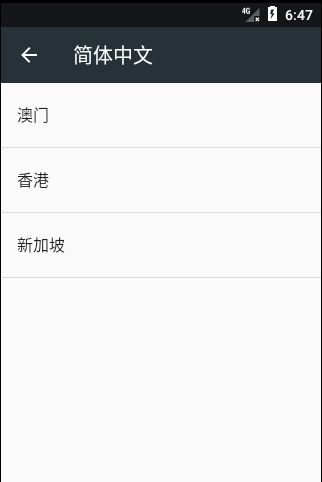Android7.0 & 8.0 Language Settings 定制
这里主要介绍如何去定制Settings中的语言,7.0以后Settings中的Languages & Input这项有了一些变化,不再是直接把语言列表显示出来了,而是下面这个界面。
选择了Add a language就会把所以的语言都列出来

再选择简体中文还会弹出一个列表

选择完一个语言后,在最开始的列表中就会多一个语言出来。

这里同时可以设置多个语言,在APK中设置语言时就会体现出来了。上面这些图片是我定制过的,删除了很多语言,所以就剩这几个了。
下面来看如何去定制的。
1.在AndroidMainfest.xml中找到Language Settings
<activity android:name="Settings$InputMethodAndLanguageSettingsActivity" android:label="@string/language_keyboard_settings_title" android:icon="@drawable/ic_settings_language" android:taskAffinity="com.android.settings" android:parentActivityName="Settings">
<intent-filter>
<action android:name="android.intent.action.MAIN" />
<category android:name="android.intent.category.VOICE_LAUNCH" />
<category android:name="android.intent.category.DEFAULT" />
intent-filter>
<intent-filter android:priority="-1">
<action android:name="com.android.settings.action.SETTINGS" />
intent-filter>
<meta-data android:name="com.android.settings.category" android:value="com.android.settings.category.personal" />
<meta-data android:name="com.android.settings.FRAGMENT_CLASS" android:value="com.android.settings.inputmethod.InputMethodAndLanguageSettings" />
<meta-data android:name="com.android.settings.PRIMARY_PROFILE_CONTROLLED" android:value="true" />
activity>这里的InputMethodAndLanguageSettingsActivity是个别名,真正的是android:value=”com.android.settings.inputmethod.InputMethodAndLanguageSettings”。
2.InputMethodAndLanguageSettings分析
我们只关注语言设置,所以找到对应的语言设置就行了,其它不看。
@Override
public void onCreate(Bundle icicle) {
super.onCreate(icicle);
addPreferencesFromResource(R.xml.language_settings);
打开这个布局文件,来寻找我们要找的语言设置。
3.language_settings分析
打开这个布局,第一个PreferenceScreen就是我们要找的语言设置界面。
<PreferenceScreen xmlns:android="http://schemas.android.com/apk/res/android" xmlns:settings="http://schemas.android.com/apk/res/com.android.settings" android:key="language_keyboard_settings" android:title="@string/language_keyboard_settings_title">
<PreferenceScreen android:key="phone_language" android:title="@string/phone_language" android:fragment="com.android.settings.localepicker.LocaleListEditor" />4.LocaleListEditor分析
这个类就是我们之前看到了,有个Add a language按钮的那张图片上的实现。我们要看这个按钮是怎么去加载语言的,所以要找到对应的按钮点击事件。这是个SettingsPreferenceFragment,我们先看onCreateView。
@Override
public View onCreateView(LayoutInflater inflater, ViewGroup container, Bundle savedInstState) {
final View result = super.onCreateView(inflater, container, savedInstState);
final View myLayout = inflater.inflate(R.layout.locale_order_list, (ViewGroup) result);
getActivity().setTitle(R.string.pref_title_lang_selection);
configureDragAndDrop(myLayout);
return result;
}这里有加载一个布局文件,上面是显示的语言,下面就是那个按钮。
<ScrollView xmlns:android="http://schemas.android.com/apk/res/android" android:layout_width="match_parent" android:layout_height="match_parent" android:layoutDirection="locale" android:textDirection="locale">
<LinearLayout android:layout_width="match_parent" android:layout_height="match_parent" android:orientation="vertical" android:paddingTop="8dp" android:paddingBottom="8dp">
<com.android.settings.localepicker.LocaleRecyclerView android:id="@+id/dragList" android:layout_width="match_parent" android:layout_height="wrap_content" android:scrollbars="vertical"/>
<Button android:id="@+id/add_language" android:layout_width="match_parent" android:layout_height="?android:listPreferredItemHeight" android:paddingStart="?android:attr/listPreferredItemPaddingStart" android:paddingEnd="?android:attr/listPreferredItemPaddingEnd" android:drawableStart="@drawable/ic_add_24dp" android:drawablePadding="24dp" android:textAlignment="textStart" android:text="@string/add_a_language" style="@style/Base.Widget.AppCompat.Button.Borderless" android:textAppearance="?android:attr/textAppearanceListItem"/>
LinearLayout>
ScrollView>然后就去LocaleListEditor中寻找add_language这个按钮的点击事件。看它是如何加载语言列表并显示的。
private void configureDragAndDrop(View view) {
final RecyclerView list = (RecyclerView) view.findViewById(R.id.dragList);
final LocaleLinearLayoutManager llm = new LocaleLinearLayoutManager(getContext(), mAdapter);
llm.setAutoMeasureEnabled(true);
list.setLayoutManager(llm);
list.setHasFixedSize(true);
mAdapter.setRecyclerView(list);
list.setAdapter(mAdapter);
mAddLanguage = view.findViewById(R.id.add_language);
mAddLanguage.setOnClickListener(new View.OnClickListener() {
@Override
public void onClick(View v) {
final LocalePickerWithRegion selector = LocalePickerWithRegion.createLanguagePicker(
getContext(), LocaleListEditor.this, false /* translate only */);
getFragmentManager()
.beginTransaction()
.setTransition(FragmentTransaction.TRANSIT_FRAGMENT_OPEN)
.replace(getId(), selector)
.addToBackStack("localeListEditor")
.commit();
}
});
}这边是新建了一个LocalePickerWithRegion对象,然后把它作为新的fragment来显示,所以就是这里去加载并显示语言列表的。
5.LocalePickerWithRegion分析
LocalePickerWithRegion是一个ListFragment,所以找到对应的adapter就可以了。上面的LocalePickerWithRegion对象是通过createLanguagePicker创建的,我们来看下这个函数。
public static LocalePickerWithRegion createLanguagePicker(Context context,
LocaleSelectedListener listener, boolean translatedOnly) {
LocalePickerWithRegion localePicker = new LocalePickerWithRegion();
localePicker.setListener(context, listener, /* parent */ null, translatedOnly);
return localePicker;
}没什么,就是去new了一个对象,直接看onCreate。
@Override
public void onCreate(Bundle savedInstanceState) {
super.onCreate(savedInstanceState);
setHasOptionsMenu(true);
if (mLocaleList == null) {
// The fragment was killed and restored by the FragmentManager.
// At this point we have no data, no listener. Just return, to prevend a NPE.
// Fixes b/28748150. Created b/29400003 for a cleaner solution.
returnToParentFrame();
return;
}
final boolean countryMode = mParentLocale != null;
final Locale sortingLocale = countryMode ? mParentLocale.getLocale() : Locale.getDefault();
mAdapter = new SuggestedLocaleAdapter(mLocaleList, countryMode);
final LocaleHelper.LocaleInfoComparator comp =
new LocaleHelper.LocaleInfoComparator(sortingLocale, countryMode);
mAdapter.sort(comp);
setListAdapter(mAdapter);
}这里回去setListAdapter,给这个ListFragment设置adapter。我们已经找到了这个adapter,然后看它怎么被赋值的。mAdapter = new SuggestedLocaleAdapter(mLocaleList, countryMode); 就返回一个SuggestedLocaleAdapter,所以要看mLocaleList,语言列表都在这里面。去看mLocaleList是怎么被赋值的,直接搜索这个关键字。
/**
* Sets the listener and initializes the locale list.
*
* Returns true if we need to show the list, false if not.
*
* Can return false because of an error, trying to show a list of countries,
* but no parent locale was provided.
*
* It can also return false if the caller tries to show the list in country mode and
* there is only one country available (i.e. Japanese => Japan).
* In this case we don't even show the list, we call the listener with that locale,
* "pretending" it was selected, and return false.
*/
private boolean setListener(Context context, LocaleSelectedListener listener,
LocaleStore.LocaleInfo parent, boolean translatedOnly) {
this.mParentLocale = parent;
this.mListener = listener;
this.mTranslatedOnly = translatedOnly;
setRetainInstance(true);
final HashSet langTagsToIgnore = new HashSet<>();
if (!translatedOnly) {
final LocaleList userLocales = LocalePicker.getLocales();
final String[] langTags = userLocales.toLanguageTags().split(",");
Collections.addAll(langTagsToIgnore, langTags);
}
if (parent != null) {
mLocaleList = LocaleStore.getLevelLocales(context,
langTagsToIgnore, parent, translatedOnly);
if (mLocaleList.size() <= 1) {
if (listener != null && (mLocaleList.size() == 1)) {
listener.onLocaleSelected(mLocaleList.iterator().next());
}
return false;
}
} else {
mLocaleList = LocaleStore.getLevelLocales(context, langTagsToIgnore,
null /* no parent */, translatedOnly);
}
//aaron
for(LocaleStore.LocaleInfo lf : mLocaleList) {
Log.i("test_language", "LocaleInfo "+lf);
}
//end
return true;
} 赋值的地方是mLocaleList = LocaleStore.getLevelLocales(context,
langTagsToIgnore, parent, translatedOnly); 继续往下追。
6.LocaleStore分析
主要看getLevelLocales这个函数
/**
* Returns a list of locales for language or region selection.
* If the parent is null, then it is the language list.
* If it is not null, then the list will contain all the locales that belong to that parent.
* Example: if the parent is "ar", then the region list will contain all Arabic locales.
* (this is not language based, but language-script, so that it works for zh-Hant and so on.
*/
public static Set getLevelLocales(Context context, Set ignorables,
LocaleInfo parent, boolean translatedOnly) {
fillCache(context);
String parentId = parent == null ? null : parent.getId();
HashSet result = new HashSet<>();
for (LocaleStore.LocaleInfo li : sLocaleCache.values()) {
int level = getLevel(ignorables, li, translatedOnly);
if (level == 2) {
if (parent != null) { // region selection
if (parentId.equals(li.getParent().toLanguageTag())) {
result.add(li);
}
} else { // language selection
if (li.isSuggestionOfType(LocaleInfo.SUGGESTION_TYPE_SIM)) {
result.add(li);
} else {
result.add(getLocaleInfo(li.getParent()));
}
}
}
}
return result;
} 这里就是循环把sLocaleCache中的值读取出来,所以要去找这个sLocaleCache在哪赋值的。赋值的地方就是fillCache这个函数。
public static void fillCache(Context context) {
if (sFullyInitialized) {
return;
}
Set simCountries = getSimCountries(context);
for (String localeId : LocalePicker.getSupportedLocales(context)) {
if (localeId.isEmpty()) {
throw new IllformedLocaleException("Bad locale entry in locale_config.xml");
}
LocaleInfo li = new LocaleInfo(localeId);
if (simCountries.contains(li.getLocale().getCountry())) {
li.mSuggestionFlags |= LocaleInfo.SUGGESTION_TYPE_SIM;
}
sLocaleCache.put(li.getId(), li);
final Locale parent = li.getParent();
if (parent != null) {
String parentId = parent.toLanguageTag();
if (!sLocaleCache.containsKey(parentId)) {
sLocaleCache.put(parentId, new LocaleInfo(parent));
}
}
}
boolean isInDeveloperMode = Settings.Global.getInt(context.getContentResolver(),
Settings.Global.DEVELOPMENT_SETTINGS_ENABLED, 0) != 0;
for (String localeId : LocalePicker.getPseudoLocales()) {
LocaleInfo li = getLocaleInfo(Locale.forLanguageTag(localeId));
if (isInDeveloperMode) {
li.setTranslated(true);
li.mIsPseudo = true;
li.mSuggestionFlags |= LocaleInfo.SUGGESTION_TYPE_SIM;
} else {
sLocaleCache.remove(li.getId());
}
}
// TODO: See if we can reuse what LocaleList.matchScore does
final HashSet localizedLocales = new HashSet<>();
for (String localeId : LocalePicker.getSystemAssetLocales()) {
LocaleInfo li = new LocaleInfo(localeId);
final String country = li.getLocale().getCountry();
// All this is to figure out if we should suggest a country
if (!country.isEmpty()) {
LocaleInfo cachedLocale = null;
if (sLocaleCache.containsKey(li.getId())) { // the simple case, e.g. fr-CH
cachedLocale = sLocaleCache.get(li.getId());
} else { // e.g. zh-TW localized, zh-Hant-TW in cache
final String langScriptCtry = li.getLangScriptKey() + "-" + country;
if (sLocaleCache.containsKey(langScriptCtry)) {
cachedLocale = sLocaleCache.get(langScriptCtry);
}
}
if (cachedLocale != null) {
cachedLocale.mSuggestionFlags |= LocaleInfo.SUGGESTION_TYPE_CFG;
}
}
localizedLocales.add(li.getLangScriptKey());
}
// Serbian in Latin script is only partially localized in N.
localizedLocales.remove("sr-Latn");
for (LocaleInfo li : sLocaleCache.values()) {
li.setTranslated(localizedLocales.contains(li.getLangScriptKey()));
}
addSuggestedLocalesForRegion(Locale.getDefault());
sFullyInitialized = true;
} 代码很长,主要看LocalePicker.getSupportedLocales(context),它就是去配置文档中把语言列表读取出来的。继续往下追。
7.LocalePicker
public static String[] getSupportedLocales(Context context) {
return context.getResources().getStringArray(R.array.supported_locales);
}所以找到supported_locales这个数组就能找到加载的语言列表了。
8.supported_locales数组
位置在frameworks/base/core/res/res/values/locale_config.xml
<resources>
<string-array translatable="false" name="supported_locales">
<item>af-NAitem>
<item>af-ZAitem>
<item>agq-CMitem>
<item>ak-GHitem>
<item>am-ETitem>
<item>ar-AEitem>
<item>ar-BHitem>
<item>ar-DJitem>
<item>ar-DZitem>
<item>ar-EGitem>
<item>ar-EHitem>
<item>ar-ERitem>
<item>ar-ILitem>
<item>ar-IQitem> 在这里定制自己的语言列表,目前只测试过删除一些不需要的语言,没有添加新的。
注意:这里的语言有分类的,可以选择地区。比如上面代码中的Arabic语言,在设置中就显示这一个选项,当你点了这个Arabic选项后,就会出现Bahrain,Djibouti等这些选项。